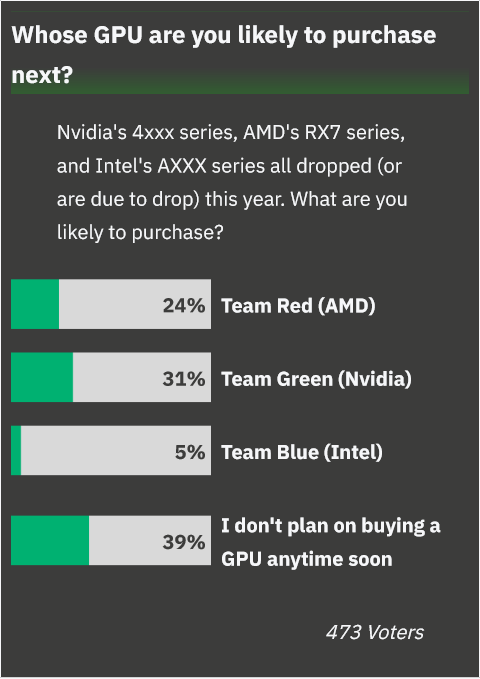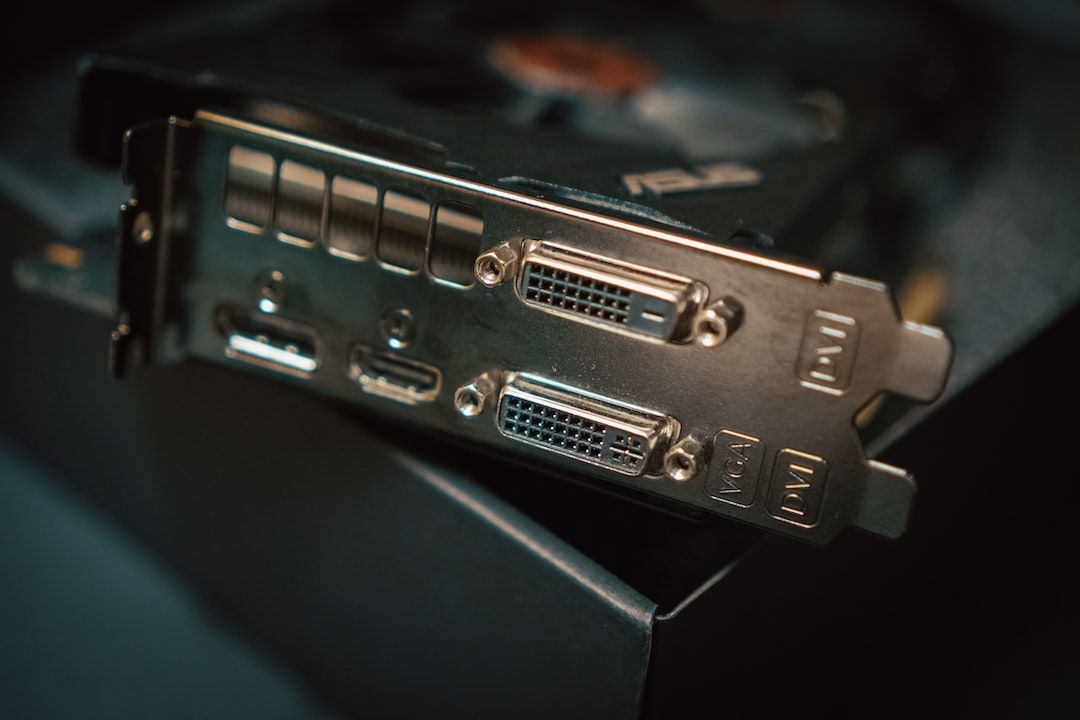Nvidia has shot itself in the foot. After spending years exclusively dominating the graphic card market, the Santa Clara, Calif.-based chipmaker has fallen prey to predatory pricing, stagnation, and, quite frankly, the same shenanigans that hurt Intel's dominance in the CPU market.
There's a new competitor in town, and while it has yet to completely usurp Nvidia's lead in the GPU market, it has already started chipping away at its market share. Yes, we're talking about AMD (who else!?), which is likely going to be the next GPU of choice for nearly a quarter of HackerNoon readers that participated in a poll asking which graphic card they were going to buy in the future.
To be sure, Nvidia still commands respect, with nearly a third of users choosing to go team green when they buy their next GPU. However, opting for team red was virtually unheard of half a decade ago, even when AMD announced the long-awaited RX Vega GPUs to compete with Nvidia's wildly popular 10-series cards.

For the most part, Intel and Nvidia had dominated the CPU and GPU markets from the early 2000s up until the late 2010s, relegating AMD to a niche given how poorly its chips performed. It didn't really help that AMD was slow to launch new products, and when it did, they would suffer from high power consumption and bad thermals, leaving it curiously absent from both the CPU and GPU markets for years on end.
Perhaps the only thing that kept AMD afloat during those years were the custom-made chipsets it manufactured for consoles, in particular the Playstation and Xbox, which ultimately ended up becoming a significant source of revenue for the Nasdaq-listed firm. But other than that, AMD really hadn't launched any products that had consumers' heads turning.
All of this changed with the 2017 launch of the Ryzen series processors that were based on a new architecture called Zen. Though not necessarily as powerful as its Intel counterpart in gaming, the flagship product from that launch — the Ryzen 7 1800X — came at a spitting distance of Intel's then leader, the i7-8700k, in productivity tasks at a much, much lower price.
Meanwhile, less powerful variants of the Ryzen 7 had a similar story to tell: they were cheaper, performed nearly as well as their Intel counterparts in productivity, and notably, came with good heatsinks so budget-conscious consumers didn't have to spend extra. Consumers entering the Ryzen ecosystem also knew that every subsequent processor launch would continue to be based on the AM4 chipset, meaning they could simply swap out their older processors for newer ones without necessarily changing motherboards.
Tech enthusiasts hailed the launch of the Ryzen 7 processors due to their potential for breaking Intel's monopoly in the CPU market, which they did. Every subsequent processor launched since the original Ryzen 7 series has shown improvements in leaps and bounds, while Intel's processors continue to provide incremental benefits over their predecessors. In fact, a HackerNoon editor was so impressed with the latest AMD processor launch (The Ryzen 9 7900X) that they decided to do the unthinkable: migrate to team red, citing not only the better performance, but, the better economics of being a part of the AMD ecosystem.
AMD has also made gains in the GPU market, starting from the launch of Vega 64, which, while reviewing modestly against Nvidia's 10 series products, couldn't necessarily compete with it because of how great the 10 series cards were in terms of both price and performance. Vega 64 was also plagued by driver issues at launch, though AMD was quick to address those issues as they came along.
But Nvidia got smug with the launch of the successor to the 10 series, perhaps hoping that consumers and tech enthusiasts would fall for its marketing and a promise for better-looking games with the ray-tracing feature. Sadly for Nvidia, reviewers panned the release, noting at the time that the 20 series cards were only incrementally better than their predecessors and the ray-tracing feature that Nvidia was charging a premium for was yet to be available across major video game titles. We personally termed the release as a 'meme launch,' signifying that anyone with a bit of time and research could figure out that the card was simply meant to make money and didn't really offer anything beyond a promise of a technology that had yet to reach fruition. Not to mention, it wasn't even that great at said technology (ray tracing).
Meanwhile, AMD still hadn't hit the mark, with the RX 5000 series cards that were supposed to compete with Nvidia's 20-series products facing issues in power consumption, thermals, and drivers. As the 30-series launch came along and Nvidia seemed to have course corrected, AMD too did not disappoint, with the RX 6000 series getting praise from reviewers for its performance, price, and availability.
Which brings us to the present: the Nvidia 4-series. And oh my god, it looks like history is repeating itself. This is yet another 'meme release' panned by reviewers for price, performance, and power consumption (not to mention the issue that shall not be named). Meanwhile, AMD's upcoming RX 7000 series cards are already touted to be cheaper and better than what Nvidia has put out.
https://www.youtube.com/watch?v=i2_xTUshy94?embedable=true
All of this to say: we get it. Nvidia, just like Intel, has become a fat, lazy dragon content with its dominance from the glory days. In contrast, AMD has consistently targeted consumers that were long forgotten by the titans: the budget gamers, who, by all accounts, make up an overwhelming majority of PC users. By positioning itself as the less expensive alternative to market behemoths, AMD has been able to claw away at its competition, all the while investing money in R&D so it too could produce products that could compete with some of the best tech out there for cheaper.
Surprisingly, a very small portion of HackerNoon readers might also opt for an Intel graphic card. While not exactly known for their graphical prowess, Intel's integrated GPUs have long been a mainstay of laptops, particularly at the lower price point. Reviewers have hailed the launch of Intel's Arc series desktop GPUs for the same reasons as they did for AMD's processors: competition, even if team blue's new product is subpar at best. With Intel's entry into the desktop GPU market, we can now only hope for a gold trifecta in which no single company calls the shots, and all three competitors keep their peers in check with performance and pricing. Only time will tell.
To wrap things up, while we know what team HackerNoon readers are leaning toward if they want to purchase a graphic card, we also know (based on the poll results) that a good chunk of readers are unlikely to buy a new graphic card anytime soon. It could be the price, the availability, or the fact that they probably don't care about a graphic card and are likely not consumers who have a need for a dedicated GPU. Or, they follow a simple principle: they don't upgrade unless what they currently have is no longer giving them the performance they seek.
To participate in Hackernoon’s current poll, head down to the following link.

